Physical Address
304 North Cardinal St.
Dorchester Center, MA 02124
A 65-year-old man developed a tingling sensation in the toes, which quickly gave way to painful numbness. Over the next few months, paresthesias ascended to involve his distal thighs and fingertips. Within 6 months, he required a walker to ambulate because of leg weakness. During the review of systems, he commented on the fogginess of vision and light-headedness that he experiences upon standing. He had fainted at least twice, and this was attributed to a newly diagnosed cardiomyopathy. Difficulty passing urine in the previous 2 months led to the placement of a urinary catheter. Prior to this problem the patient had enjoyed good health except for an IgG kappa monoclonal gammopathy of unknown significance (MGUS), which was regularly monitored. Neurologic examination demonstrated diffuse atrophy of the posterior shoulders as well as the hands and thighs. Distal bulk could not be assessed due to edema. Leg weakness was moderate and predominantly distal. Thenar muscles in both hands were atrophic and weak, and the patient was areflexic. Sensation was absent to all modalities up to the distal thighs and also in the median nerve distribution of the hands. Laboratory work demonstrated proteinuria. Nerve conduction study revealed severe length-dependent sensorimotor polyneuropathy, chiefly axonal but with some borderline motor conduction velocities (33 m/s) in the peroneal nerve, which raised the possibility of a demyelinating component. In addition, bilateral carpal tunnel syndrome was demonstrated. Primary amyloidosis with sensorimotor and autonomic neuropathy was strongly suspected. Abdominal fat pad aspiration revealed characteristic amyloid deposits around blood vessels.
Evaluation of the etiology of a patient's polyneuropathy can be challenging for many reasons, including the fact that there are more than 100 potential etiologies. Ultimately the polyneuropathy is determined to be acquired (i.e., caused by some other disease or exposure) in one-third of cases ( Box 67.1 ), inherited in another one-third, and idiopathic in the remaining one-third. In order to focus on a smaller list of potential etiologies so that the evaluation can be simplified, we believe that it is best for the clinician to first characterize the polyneuropathy. This chapter presents a method for characterizing neuropathy that is easy to remember, based on four simple clinical questions about the neuropathy and the patient: “What?” “Where?” “When?” and in “What setting?”
Diabetes mellitus and impaired glucose tolerance
Toxins (alcohol, medications, chemotherapeutic agents, heavy metals)
Metabolic syndrome (obesity, hypertriglyceridemia)
Nutritional deficiencies (B12, B1, B6, copper)
Vitamin excess (B6)
Connective tissue diseases
Paraproteinemia
Vasculitis
Amyloidosis
Critical illness
Uremia
Infection (HIV, Leprosy, VZV, Lyme)
Malignancy/paraneoplasia
Sarcoidosis
HIV, Human immunodeficiency virus; VZV, varicella zoster virus.
“What?” refers to what nerve fiber modalities (motor, sensory, autonomic, or a combination) are involved. The identification of sensory nerve involvement, at a minimum, allows the clinician to exclude other neuromuscular diseases not associated with sensory dysfunction, such as disorders of anterior horn cells (e.g., amyotrophic lateral sclerosis), neuromuscular transmission (e.g., myasthenia gravis), or of muscle (myopathy). When sensory symptoms and signs are present, it is useful to characterize neuropathic sensory symptoms into “positive” or “negative” because acquired neuropathies are usually accompanied by positive neuropathic sensory symptoms and inherited neuropathies are usually not. Positive sensory symptoms may be painful (e.g., “burning,” “freezing,” or “shooting”), usually indicating involvement of small fibers, or symptoms may be painless (e.g., “tingling” or “swelling”). The presence of pain can be a very helpful in differentiating features because it limits the list of possible etiologies ( Box 67.2 ). Positive sensory symptoms and pain are common complaints for patients with diabetic, vasculitic, or alcoholic neuropathy or those with Guillain-Barré syndrome (GBS). Exaggerated discomfort to painful stimuli (hyperalgesia) and to nonpainful stimuli (allodynia) can occur. Painless symptoms, both negative (“numbness,” “woodiness”) and positive (“socks bunched up under one's feet,” “swelling”), are more common in patients with large-fiber involvement. Sensory ataxia from loss of proprioceptive large sensory fibers is another of the negative neuropathic sensory symptoms; patients report imbalance in the dark or after they close their eyes in the shower.
Diabetes and impaired glucose tolerance
Metabolic syndrome (obesity and dyslipidemia)
Alcohol
Other toxins (including chemotherapeutic agents)
B-vitamin deficiencies: thiamine, B 12 , B 6 ,
Sjögren syndrome and other connective tissue diseases (length- and non–length dependent)
Amyloidosis—primary systemic, and inherited
Hepatitis C and cryoglobulinemia
HIV neuropathy
Hereditary (Hereditary sensory neuropathy, Fabry, Tangier)
Vasculitis (25%–30% of cases present as LDPN, multiple mononeuropathy more typical)
Diabetes mellitus
Infection (leprosy, Lyme, VZV)
Infiltrative process (malignancy, sarcoidosis, amyloidosis)
Lewis-Sumner syndrome (MADSAM)
Guillain-Barré syndrome
Infiltrative process (malignancy, sarcoidosis)
Infection (Lyme, VZV, CMV, EBV)
CMV, Cytomegalovirus; EBV, Epstein-Barr virus; HIV, human immunodeficiency virus; LDPN, length-dependent polyneuropathy; MADSAM, multifocal acquired demyelinating sensory and motor; MM, mononeuritis multiplex; SN, sensory neuronopathy; VZV, varicella zoster virus.
Identification of autonomic nerve involvement can be an important clue because only a small number of neuropathic processes affect both autonomic and somatic nerves (e.g., GBS, paraneoplastic neuropathy, diabetic neuropathy, amyloid neuropathy) ( Box 67.3 ). Autonomic symptoms include light-headedness, syncope, diarrhea, constipation, postprandial bloating, early satiety, urinary complaints, erectile dysfunction, abnormal or absent sweating, and dry mouth and eyes ( Fig. 67.1 ). In the foregoing vignette, our patient's symptoms of burning numbness as well as dysautonomia suggested early involvement of small unmyelinated sensory and autonomic fibers, a pattern commonly seen in neuropathy associated with amyloidosis.
Diabetes mellitus
Amyloidosis (hereditary or primary)
Toxins (chemotherapeutic agents, heavy metals)
Immune-mediated (Sjögren syndrome, connective tissue disease)
Immune-mediated/paraneoplasia
Hereditary sensory and autonomic neuropathies
HIV-related polyneuropathy
Guillain-Barré syndrome
Porphyria
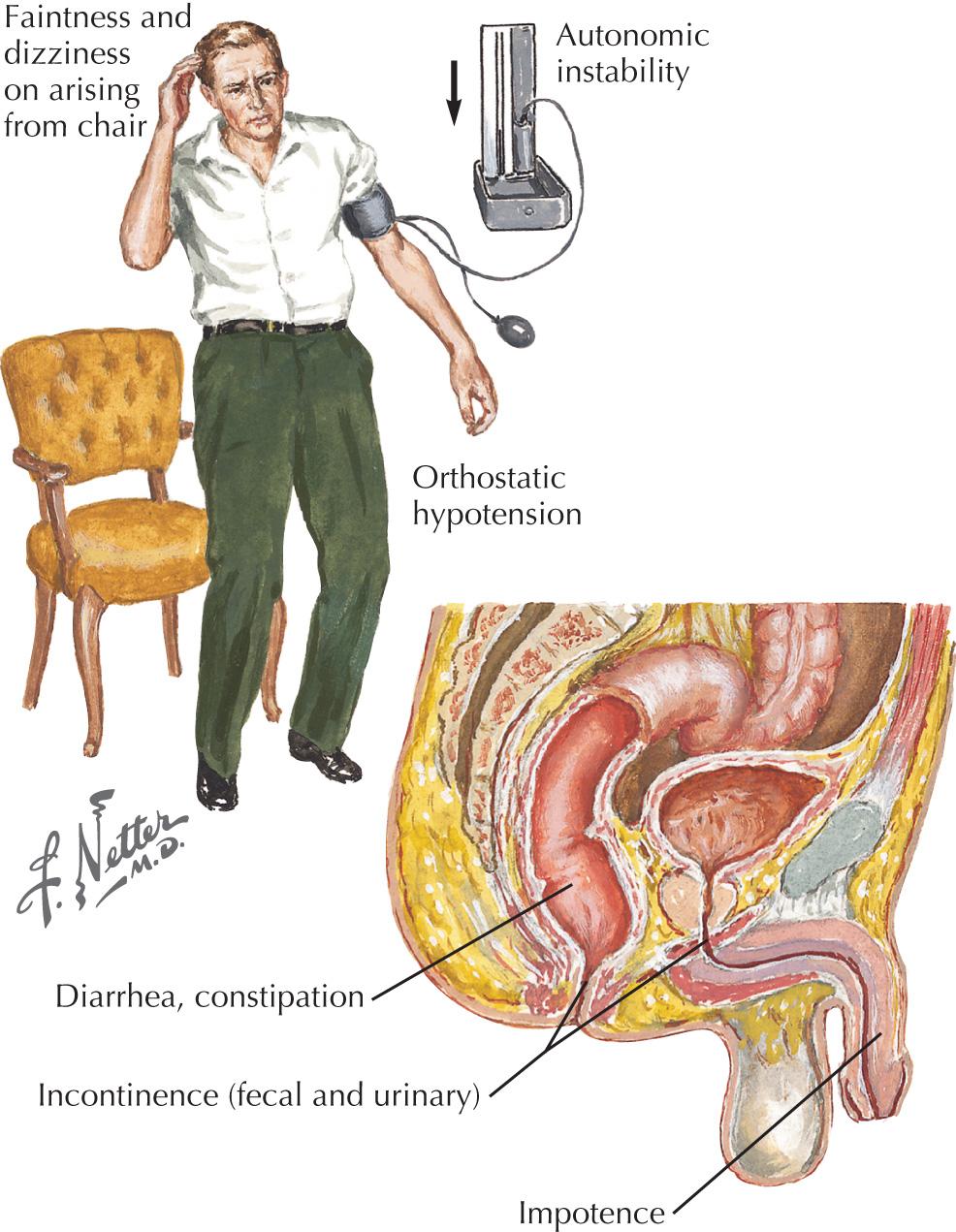
“Where?” refers to the distribution of nerve damage. An important diagnostic watershed is the determination of whether the process is “length-dependent” (e.g., distal) or not. Length-dependent neuropathies manifest first in the feet and are symmetric. Non–length-dependent neuropathies are not necessarily evident initially in the feet and may be asymmetric, focal, or multifocal. The etiology of length-dependent neuropathies is usually inherited, metabolic/toxic, or idiopathic, whereas a neuropathy that is not length-dependent is often caused by an immune-mediated or infectious process. Some examples of non–length-dependent neuropathies are polyradiculoneuropathies (e.g., GBS), plexopathies (often inflammatory), sensory ganglionopathy (e.g., paraneoplastic subacute sensory neuronopathy in the setting of small-cell lung cancer), and multifocal mononeuropathies (e.g., mononeuritis multiplex caused by vasculitis). Our vignette's patient had a combination of two patterns; length-dependent polyneuropathy and focal median neuropathies at the wrist (carpal tunnel syndrome), both produced by infiltration of amyloid fibrils.
“When?” refers to the temporal evolution of the neuropathy. Because of confusion over what is meant by “acute,” “subacute,” and “chronic,” it is often best to describe symptom onset based on whether or not the neuropathic symptoms had a compelling, definite date of onset. A definite date of symptom onset almost always indicates an acute or subacute onset typical of an immune-mediated or infectious etiology. A less exact date of onset suggests gradual or insidious onset, indicative of inherited, idiopathic, or toxic/metabolic etiologies. The pace of progression following symptom onset is also an important consideration. Symptom onset and pace of progression often correlate in a predictable manner, owing largely to the underlying mechanism. As an example, mononeuritis multiplex caused by systemic vasculitis typically presents with a series of painful mononeuropathies of acute onset, occurring one after the other with the rapid development of significant morbidity. In our patient, on the other hand, the onset was less well defined but the pace of progression was relatively rapid, rendering the patient significantly disabled within several short months. This tempo is too fast for diabetic or inherited neuropathies and too slow for an infectious etiology. It is, however, quite consistent with an immune-mediated or infiltrative process.
“What setting?” refers to an elaboration of the unique clinical circumstance of the individual patient. This is done by determining what in the patient's past medical history, medication list, social history, family history, and the review of systems may be relevant ( Fig. 67.2 ). An understanding of the significance of these clinical factors requires knowledge of the risk factors of neuropathy and of the clinical features of the diseases that may be risk factors for neuropathy. For example, unexplained weight loss raises concern for vasculitis or malignancy (e.g., small-cell lung cancer), both of which cause an immune-mediated neuropathy. The neuropathy secondary to malignancy (e.g., paraneoplastic neuropathy) usually presents differently than vasculitic neuropathy, so it is usually not too difficult to differentiate these two etiologies ( Fig. 67.3 ). A clinical setting of known diabetes mellitus or known kidney disease would elevate those comorbidities on the differential diagnosis. Heavy metal poisoning or other intoxication, although rare, must be considered in the patient with systemic symptoms (e.g., nausea, vomiting) and other manifestations suspicious for poisoning ( Fig. 67.4 ). As in the case of our vignette, known IgG kappa monoclonal gammopathy of unknown significance (MGUS) was an important clue alerting the examiner to the possibility of a neuropathy related to paraproteinemia.
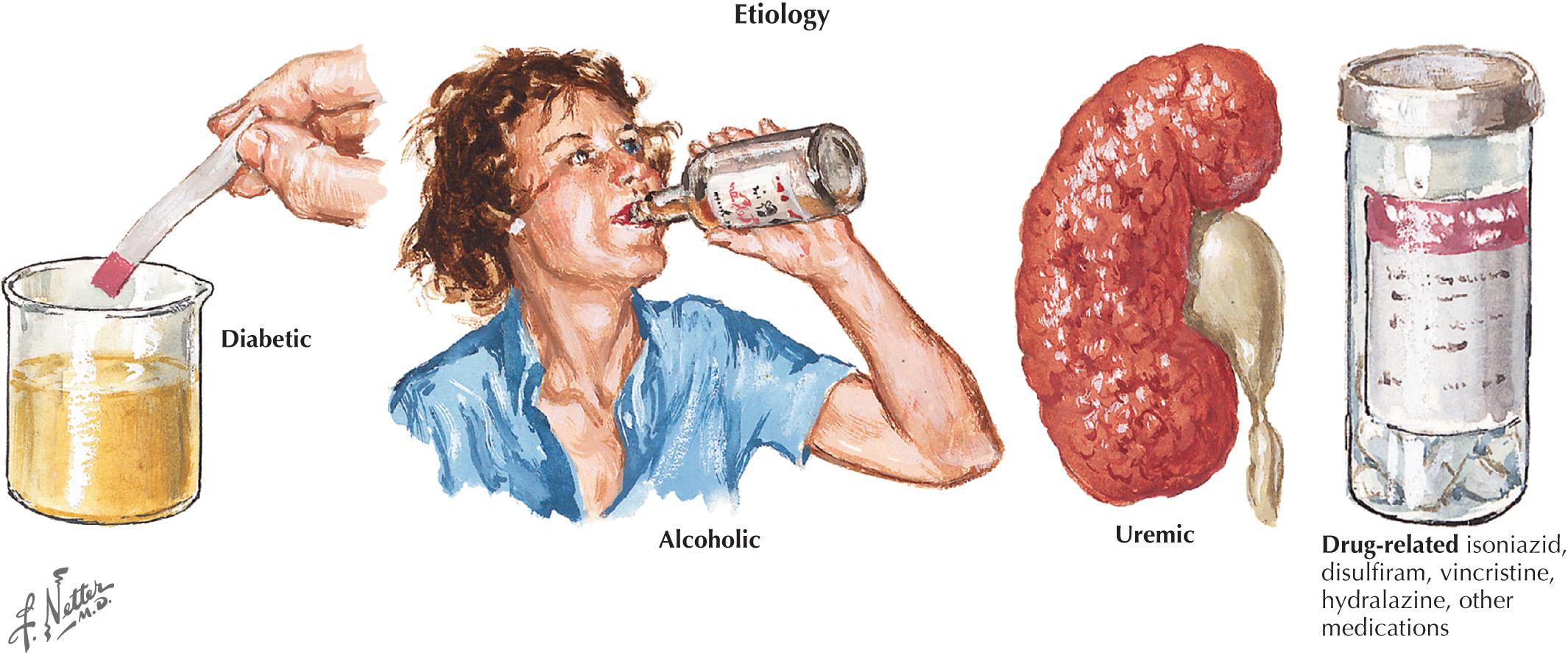
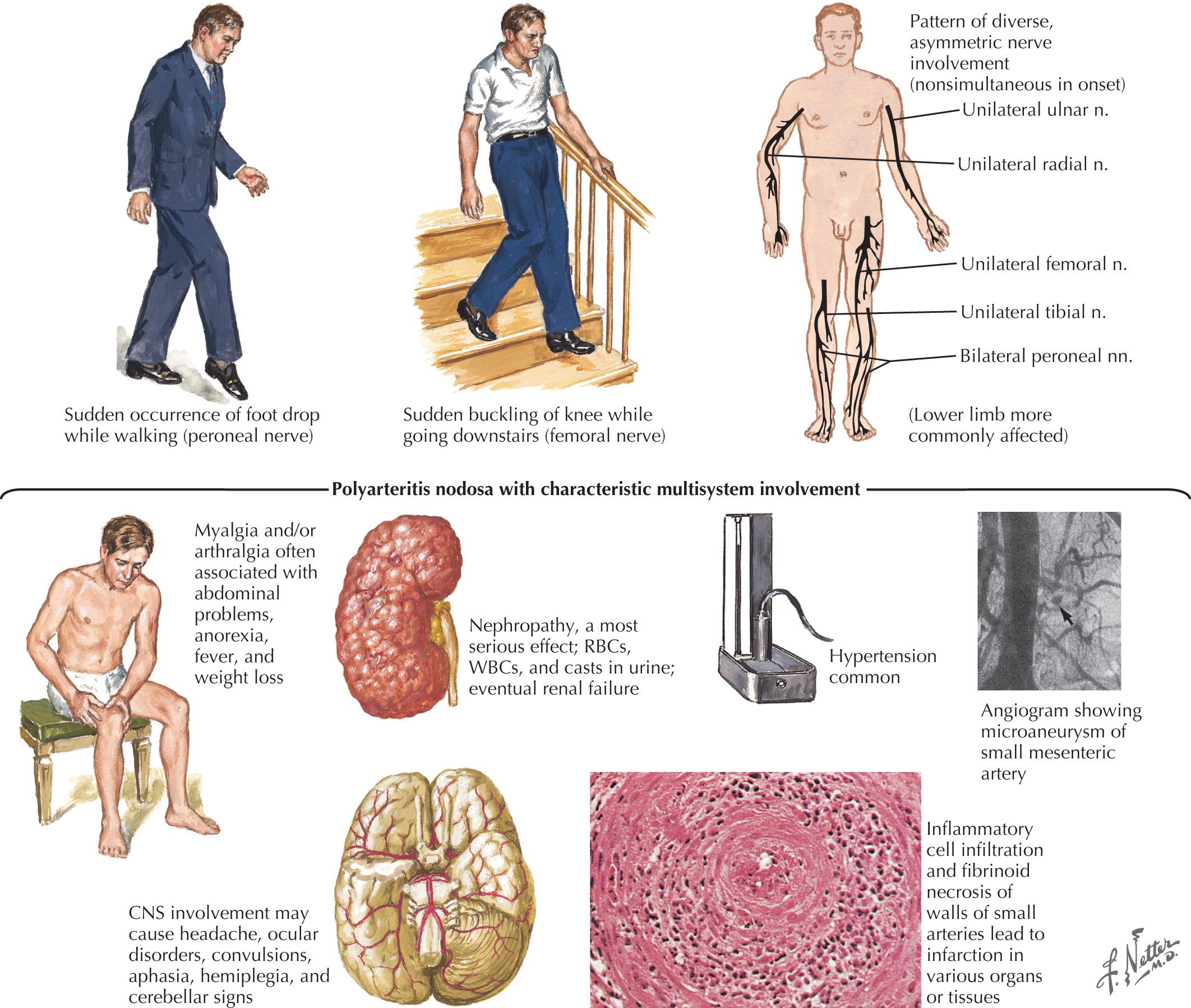
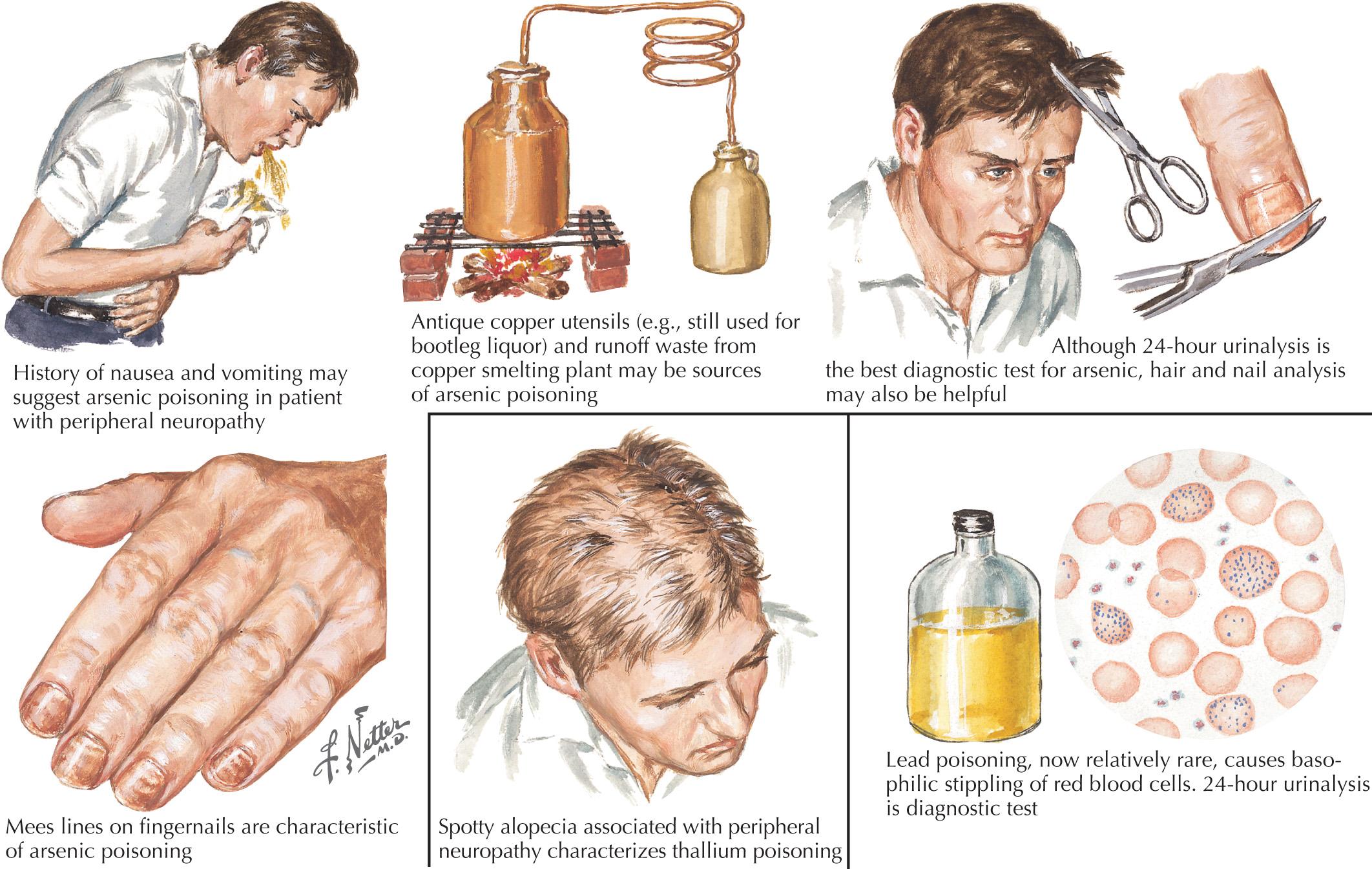
The fifth step in characterization requires nerve conduction studies (NCSs) and electromyography (EMG). NCS and EMG can contribute to (or rarely refute) the clinical characterization in terms of “what” and “where,” as well as provide another view of the temporal evolution (“when”). NCS and EMG can also characterize the neuropathy as being primarily axonal or demyelinating. Neuropathies with axonal injury are far more common than those with demyelination, but identification of demyelinating features is very important because acquired demyelinating polyneuropathies (e.g., GBS, CIDP, MMN) are often immune-mediated and treatable ( Box 67.4 ). However, our historical concept of dividing neuropathies into disorders of myelin or axon may be too simplistic. It is now recognized that in some immune-mediated neuropathies, the primary targets are proteins and ion channels in the region of the node of Ranvier ( Fig. 67.5 ). Acute motor axonal neuropathy (AMAN), the axonal motor variant of GBS, is the prototypic nodopathy; antibodies against GM1 ganglioside—an axolemmal nodal antigen—lead to disruption of sodium channels. The ultimate outcome can be a spectrum ranging from fully reversible conduction failure to irreversible axonal degeneration.
A 65-year-old woman reported a 10-month history of painful burning in her toes, particularly at night when her feet came into contact with the bed sheets. She had no symptoms in her hands or face, nor did she have indications of dysautonomia or systemic illness. She was not aware of any weakness. Her medical history included hypertension and hyperlipidemia, and she was taking a diuretic and a multivitamin. Neurologic findings revealed an overweight woman with a body mass index (BMI) of 36. Muscle stretch reflexes were normal in the arms and diminished but present at the knees and ankles. There was a distal stocking-distribution sensory loss to light touch, pinprick, and temperature, but vibration and proprioception were intact. Nerve conduction study (NCS) and electromyography (EMG) were normal. The patient's laboratory tests showed hypertriglyceridemia and mildly elevated hemoglobin A1c (5.7%). Punch skin biopsy with measurement of epidermal nerve fibers was abnormal at the distal side; density at the ankle was 2/1-mm (fifth percentile for gender and age = 3.3), whereas proximal density was normal. She was diagnosed with small-fiber neuropathy (SFN) in the setting of metabolic syndrome. She was referred to medical weight-loss clinic and educated about the benefits of regular aerobic exercise and a low-fat diet.
Comment: The symmetric pattern of painful burning in the feet with intact reflexes, strength, and normal sensation of large-fiber sensory modalities is consistent with SFN. Many of these conditions are seen in association with prediabetes and other components of metabolic syndrome, mainly obesity and dyslipidemia.
Length-dependent polyneuropathy pattern
Anti-MAG neuropathy
Polyradiculoneuropathy pattern
Guillain-Barré syndrome/AIDP variant
CIDP
Diabetes mellitus
POEMS syndrome
Multifocal neuropathy pattern
Multifocal motor neuropathy with conduction block (MMN)
Multifocal CIDP (Lewis-Sumner syndrome, MADSAM)
Length-dependent polyneuropathy pattern
Charcot-Marie-Tooth disease (types 1, 3, and 4)
Metachromatic leukodystrophy
Globoid cell leukodystrophy
Multifocal pattern
Hereditary neuropathy with liability to pressure palsy
CMTX
AIDP, Acute inflammatory demyelinating polyradiculoneuropathy; CIDP, chronic inflammatory demyelinating polyradiculoneuropathy; CMT, Charcot-Marie-Tooth disease; CMTX, X-linked CMT; MADSAM, multifocal acquired demyelinating sensory and motor neuropathy; MAG, myelin associated glycoprotein; POEMS, polyneuropathy, organomegaly, endocrinopathy, monoclonal gammopathy, and skin changes.
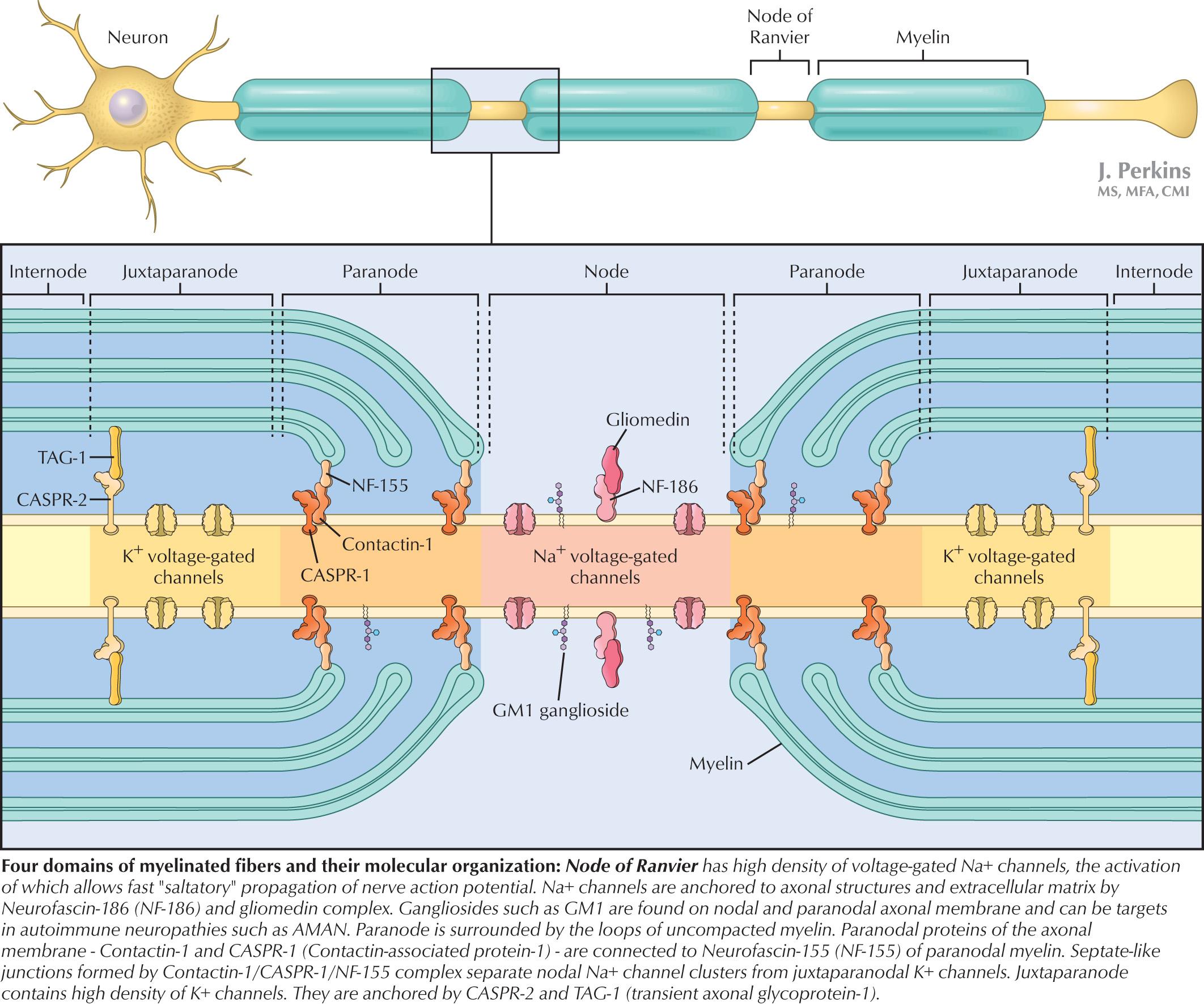
Polyneuropathies are among the most common neurologic disorders; the length-dependent pattern is the most prevalent. Also referred to as distal symmetric polyneuropathies (DSPs), the majority of these are axonal, symmetric, and sensory-predominant. Nutrition and other functions of nerve axons rely on metabolic activity of their cell bodies (dorsal root ganglia or anterior horn cells) and on effective axonal transport. When these mechanisms are disrupted, it is the most distal parts of the longest axons (i.e., in the toes) that become most vulnerable and degenerate, leading to the distal-to-proximal gradient of sensory and motor abnormalities (“dying back”). Demonstration of the length-dependent pattern in a patient with polyneuropathy is among the essential exercises in clinical neurology; in a typical patient, the neuropathy does not reach the fingers until lower extremity symptoms have ascended to the knee level. In advanced cases, the scalp vertex and midline trunk are involved. A similar distal-to-proximal gradient applies to the motor exam and muscle stretch reflexes.
Typical patients with length-dependent polyneuropathies (LDPNs) note tingling, numbness, or pain in their toes and feet. They describe a sense of swelling, feeling as though their socks are bunched up under their feet, or a sensation of having cotton between their toes. Motor involvement is often present on EMG but not clinically. If it is seen clinically, big-toe extensors are the first affected muscles. Ankle muscle stretch reflexes can be absent or diminished.
As in the case of our vignette, dissociation of separate sensory modalities may lend valuable clues. A small-fiber sensory neuropathy (SFN) is suggested by burning in the feet of patients with impaired pain and thermal sensation and sparing of vibration and proprioceptive sense. The EMG is characteristically normal. Most SFNs do not have identifiable etiologic mechanisms, but careful evaluation for diabetes, prediabetes, and other components of metabolic syndrome is required (see Box 67.2 ).
Most but not all sensory LDPNs have subclinical motor involvement on EMG. Those that are pure sensory neuropathies can be seen in the context of diabetes mellitus, renal disease, vitamin deficiencies, various toxins, Sjögren syndrome, and amyloidosis. Some probably represent a primary sensory ganglionopathy with distal-predominant presentation. Neuropathic pain and dysautonomia are variably present, depending on the underlying etiology (see Box 67.3 ).
Motor-predominant LDPNs are primarily genetically determined (i.e., CMT and distal hereditary motor neuropathies [dHMNs]) or, less commonly, immunologically acquired multifocal motor neuropathies presenting in a confluent LDPN-like fashion.
Become a Clinical Tree membership for Full access and enjoy Unlimited articles
If you are a member. Log in here